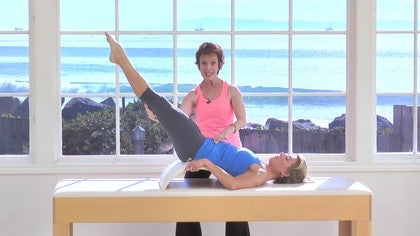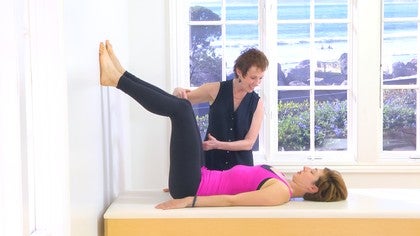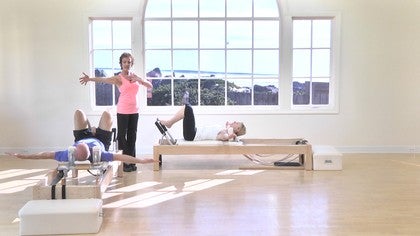Description
About This Video
Transcript
Read Full Transcript
I'm Debra Cole away and I'm very happy to be back at [inaudible] anytime. Come with me and Christi on a little journey today into the center of your body, into the center of the Earth, up into the heavens and how this upright human being that you are can relate both to itself and to its world. So join us if you like Christie, go ahead and get comfortable. Take a nice stance and feel your feet on the ground. And today I'm going to do is work with a concept that I am borrowing from Eve gentry though I believe she wouldn't mind that.
I've embellished it a little bit, that as we are here as upright human beings, we're connected both to the ground and to the heavens and our body is essentially a combination of verticals and horizontals. So your verticals you could think of as your spine and your limbs. Sometimes it's nice to think about having six limbs, so ahead, a tail, two arms and two legs and then you have your horizontals. Your horizontals are across your horizon, where you scan your vision in a way you could think of it as where the, the head balances itself on top of the spine, your shoulder girdle, so across your chest. Eve didn't really talk about the ribs so much as one of the horizontals, but I like too, because I think it's, uh, an interesting area of the body that we have a hard time feeling into three-dimensionally. We're real aware of the front of our ribs.
We have a little harder time kind of breathing and getting into the back of our ribs. Then of course, across the hip line, another horizontal knees, ankles, and you could even think of your toes as a kind of horizontal that is balanced with the verticality through the center of your ankle, knee, hip, et cetera. So we think about posture. We think about good posture. We think about alignment. What are we aligning with? Why do we care about good posture? What is good posture? Well, we want to be able to be responsive to our environment. We don't want to be stuck. We don't want to be fixed.
We want to be able to respond, react to what comes our way, and have choices about how we do that response. So if you think of your verticals hanging and your horizontals floating and everything is in this constant dynamic balance around the central axis, it's kind of like there were beautiful mobile and you could think of yourself hanging from a delicate string from the ceiling and all your parts are just constantly breathing and moving and responding to each other. So as you stand there, take a few nice deep breaths and allow the spine have whatever image you come up with that helps you feel your most central channel of your body. Let it go down. Let your spine release down, make sure the knees are not locked, and it's almost as if there was a little stool behind you and that's your tail stool. Okay? So your spine releases down and you can sit on your tail stool, your two legs can release and go down.
Your feet can open like lily pads into the earth beyond the earth as far down below this building. As you could imagine, your knees can go Dow, your hips, God forbid, should release down, right? And then your arms can release down. You can think of your arm releasing out of your horizontal collarbone and releasing down, and then your other arm releasing out of the horizontal and releasing down. And then you have one thought of up. So that not only is everything releasing down into the earth, but you also have one up. So from the very center of your head, you release up.
And as you stand there and feel your breath moving through, you just feel what you feel. And notice what that is for you to be with that concept of my verticals are hanging. Excuse me, my verticals are yes hanging and my horizontals are floating. And now start to focus into your feet. Have a sense of all those 10 toes, big total little toe, little toe to big toe. Move back a ways in your awareness.
Feel right in front of your ankle bones. Feel the weight there. Take your weight a little in your awareness. Feel the center of your heel. And just like a kid, how we used to trace our friends on paper on the floor. Imagine if you were tracing your own feet and where would the dark parts be? Well, if you were standing on paper, okay, okay. Feel that. Okay.
And now remembering the, the one up. Start to circle around the very center of your ankle joint. And you don't, you don't want to scare yourself. You don't want to worry about falling and keep your eyes open. You can close your eyes.
But notice what happens when you do this circle. And can you feel every little bit along the way? And what about those parts that you want to skip over, right? And when you notice that you get a little jolt of, Ooh, I don't want to go there. What is the rest of your body do? Can it respond? Does it tighten? Does it grip?
And now start going the other way. So you're going to circle around what you sense is the very center of your ankle. And as you relax with this, other parts of your body are going to reveal themselves. And you never know what you will feel, what you will notice about yourself relative to how balanced you feel or don't feel in the central axis. Now go back the first way and make the circle out more to the edges of your body. So instead of circling around the centers of those joints, feel like you're more out at the edges of your skin.
And as you go, don't, don't scare yourself. You can always come back into a smaller circle. Yeah. And you, you might notice something about you that you know about you. Oh yeah. That jaw tightness. Oh yeah. That go the other way now. So we have our, our most central sense of ourselves vertically. We have our horizontals that can respond to our environment.
Then we take it a little further out. We kind of feel ourselves, the edges of ourselves, and then one more set going back the other way. I think two, three feet out. It doesn't mean that you have to move that big, but you do the circling. Can you feel your energy releasing out into space? Can you feel it in three dimensions?
Can you still feel your whole foot, how the weight shifts, but it doesn't have to roll or fall. It just ships. And then the other way, and if it's okay with you, do a few more and think back to the horizontals. And as you go to the right side, now notice outer right inner right inner left, outer left, inner left, inner right outer right. It's as if you had these horizontal letter. Do you lined through your ankles through your hips?
Outer right inner right and her left out or left and her left inner right outer. No, come up into the shoulders in her left out or left inner right outer right. Let's do one more the other way. [inaudible] inner right outer right in her left outer left. And then just find your way back to the center. And there you are. So you know, somebody can tell you so many things about good posture, but there's also something really wonderful and beautiful about taking the time to actually feel into what is before all the instructions, all the corrections, all of the outside information. And when you align yourself this way with your verticals, with your horizontals inside, outside space, and you start to move, you will start to feel things that will come up and they'll reveal themselves too. And they might mean something to you. They may not.
But it's a really interesting path. And the other thing that I want to share with you today about foster and balance is this idea that we have basically three weight centers that want to be balanced and in relationship with each other. Yeah, we've got ahead of thorax, a pelvis. And the image that I like to use for this is um, you know those three hanging baskets that you put in your kitchen for garlic. Yeah, you could put underwear, you know, if it's in the bedroom, whatever. So you've got a smaller medium and a big, and there's that string that hangs through them so that it moves right there hanging. But if you put all the grapefruit, you know, in one side, then the thing's gonna tip. All right, so you have, you would ultimately like these things to be balanced. And for most of us, probably primarily because our eyes are in the front of our head and we walk forward more than we walk back and we sit at computers, et cetera.
Our energy is a little forward and down, right? Just a little kind of forward and down. And we could correct ourselves, you know, we could pull our shoulders back and then somebody would have to tell us to pull our ribs in and whatever it is. But there's a really wonderful feeling that you can have. You think about your three hanging baskets, going back to the, the foundation of your, your verticals in your horizontals, always in play.
And that instead of, if you are, you know, a little forward head ish, computer facie, you know, kind of down, instead of just pulling your Chin in, right? Allow your skull to literally come a little back and a little up. So the roundness of it, the circularity of it, if it's a little forward and a little down, let it just come a little back and a little up. And the same with the ribs. Instead of thinking you have to pull those ribs in, go ahead and separate your feet a little bit. What if you could just let those ribs calm a little back and a little up.
So instead of fixing this, get it more room instead of being so quick to crack that whip, you know, and like, no, that's not good. Make it go away. Let's look at the wholeness of your structure and balance it out by giving the pattern that you have given a little bit more room to make its own mind up. Right. And then with regard to the pelvis, if most of, if some of you know some of the thoughts, I can't say most are a little hanging down, a little locked out. We know that pattern. What if we just play with it a little back and forth, back and forth, the whole structure and maybe the palace could come a little back and a little up and then you can just bend your knees and sit on my leg.
You can do it. Sit sits it. Don't worry. I got, Gotcha. And then just really let yourself have your tail stool again, right, and the back of the skull, a little back, a little up the ribs, a little back, a little up and there you are. And then you could see, you could feel your feet right. You could feel your horizontals across the ball joints. You could feel your outer inner inner, outer ankle.
You can feel your outer inner inner, outer knee. You can feel that outer inner inner, outer hip. You could allow the spine to rest down into the pelvis and then you could have your thought, your one thought of up, and then when you go to stand, you can just shift your weight enough forward to rise. You don't have to lock out your knees and you can actually balance in those three dimensions and then go ahead and do a roll down. Give me your forehead.
Just allow me the weight of your forehead is best you can give me the weight. Give me the weight. If you're comfortable to bend your knees a little, you're welcome to do that so you're not going to sit back. You're going to keep releasing that spine. There you go. And then on the way up, find your vertical hanging legs, your horizontal support. Keep releasing into my hand.
Feel the legs grounding down. Keep giving me the weight, keep giving me the way he'd given me, the way he giving me the weight. And then there you are. And then don't press out into your eyes. Okay? When you look and you see what's in your vision, instead of having to push back out into your face again, whatever that is, just let it come into you. Let it come into you, and you can rest. You can rest in the middle of the whole thing. A lot of the exercises that we do, we're lying on our back to start out right?
And we don't always take the time and standing work. And the truth is mostly we spend our days up, right? Well, you know, sometimes, maybe, I don't know, we don't spend all their time lying on our back, but we can take this experience and this kind of flow and this kind of balance into everything, into the most mundane mat exercises that you want to do. And, and, um, I'm going to be addressing that, you know, and the other tutorials, I just, um, I just think it's a wonderful thing to be given the opportunity, have enough structure so that your mind can relax. You're not wondering, what should I be doing? What should I be doing? You know, enough structure so your mind can relax and let go. It's job of having to take care of you in that way, but then really feel into yourself, as I said, and let things reveal themselves. You know, so much more about your body and what your body needs to come into balance to come into alignment, to help you.
Mindful Movement: Transitional Moments
Comments
Looking at the ankles, knees and hips, as a way to find our way to the centers of these joints...So, as you stand for example and play with your weight shifting, through center, the lateral (outer) malleolus (ankle) bone would be "outer right". Then one can sense the shift of weight through the center of the joint over to the medial, (inner) ankle bone, and then on over to the other leg. It's the same idea for the knees, and laterally translating through the pelvis and hip joints. If you want to discuss it further feel free to email me directly! Thanks, Debora
You need to be a subscriber to post a comment.
Please Log In or Create an Account to start your free trial.
























